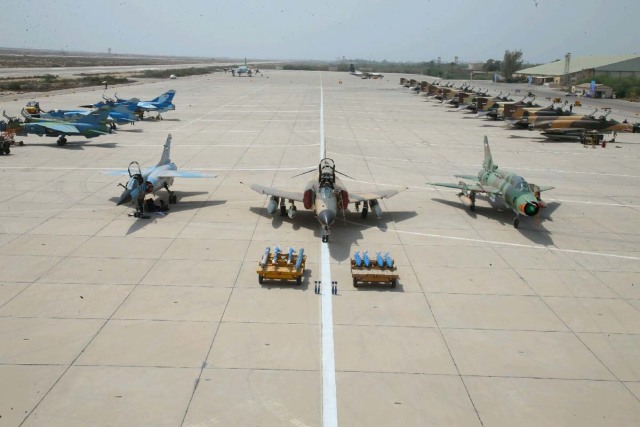The continuing increase in tensions between Iran and the United States, the high probability of Israeli strikes on the country's nuclear facilities raise the question of the readiness of the Islamic Republic of Iran to repel possible military aggression. In this regard, the potential of the air and air defense of Iran and, in particular, its combat aviation is of interest.
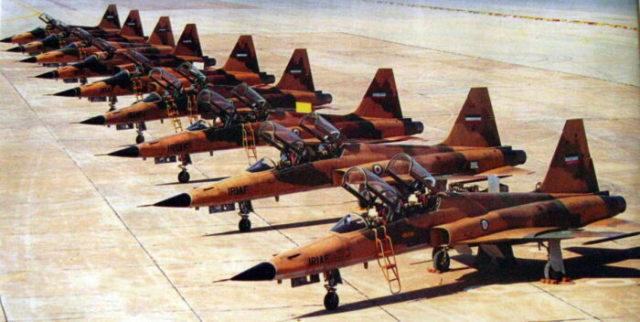
F-5 Tiger fighters of the Iranian Air Force
IRI Combat Aviation: from Pahlavi to the early 1990s
After the 1979 Islamic Revolution in Iran and the overthrow of the Western-oriented Shah Pahlavi dynasty, the basis of the National Air Force combat aviation fleet consisted of modern for that period light Tiger fighters (F-5E Tiger II), medium multi-purpose Phantoms (F-4D/E Phantom II) and heavy high-altitude interceptor fighters"Tomket" (F-14A Tomcat). The vast majority of Iranian aviation equipment was of American origin.
The restructuring of Tehran's foreign policy and the departure from cooperation with the Western bloc led to the fact that the country stopped purchasing weapons systems manufactured in the United States and lost the opportunity to purchase spare parts for servicing existing platforms. The current situation threatened to decommission most of the combat aircraft of the Iranian Air Force over the next five years, which was widely predicted by Western analysts.
Faced with a large-scale invasion from neighboring Iraq just a few months after its formation, Iran was forced to invest heavily in military aviation in order to protect its own airspace and avoid a complete loss of its control. The country's leadership directed its investments to the development of domestic spare parts production capabilities, which allowed aircraft to fly during the Iran-Iraq war. Other efforts were focused on the creation and maintenance of capacities for the repair and modernization of existing aviation equipment, its equipping with weapons and radio equipment of domestic production, as well as, with the support of foreign partners, on the development of new models of aircraft and aircraft weapons (ASP). This trend continues to the present time.

Khatami Air Base. The takeoff of a pair of F-14. Photos from the Iran-Iraq War
The significant technological base created by Iran for servicing aging aircraft was important for further strengthening the national aviation industry. It remained relevant even after the end of the Iran-Iraq war in 1988, since Iran could not acquire new aircraft after 1991. Over the next three years, with interruptions, Iran began the transition to Soviet and Chinese weapons. The Islamic Republic has placed orders for two squadrons of fourth-generation Soviet MiG-29A aircraft and one Su-24M squadron, as well as one squadron of third-generation Chinese F-7 (J-7) fighters.
Later, Iran showed interest in further purchases of MiG-29 and Su-24, as well as MiG-31 heavy interceptor fighters. However, after the collapse of the Soviet Union, due to the nature of the new Russian government, which turned out to be susceptible to Western pressure, the next negotiations ended in failure. At that time, the United States went so far that, if necessary, they promised to pay Russia themselves so that it would not sell weapons to Iran. In the end, the scale of these efforts made North Korea the only major supplier of weapons to Iran. The Korean side provided the Iranian partner with the first combat tanks, howitzers and ballistic missiles. In Russia, Iran was able to purchase S-200 air defense systems and a production line for T-72 tanks, but more powerful weapons, including all classes of fourth-generation combat aircraft, remained banned.
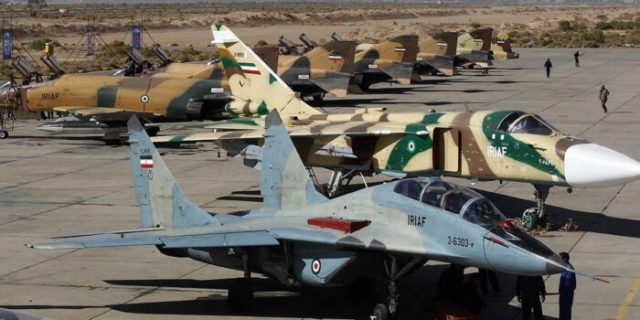
Su-24 and MiG-29 of the Iranian Air Force
Resuscitation of the F-14 Tomket aircraft fleet
Nevertheless, Iran continued to invest in the modernization of the existing arsenal. First of all, it concerned the expansion of the fleet of F-14 Tomket fighters, which were decommissioned for several decades. Among other things, the complex of events included:
- equipping machines with new sensors and electronic warfare systems of local production;
- phased replacement of the American Phoenix air-to-air missile (AIM-54 Phoenix) with the Iranian Fakour 90;
- training more crews to fly on this difficult-to-control two-seat aircraft.
Iran placed an order for 80 F-14 aircraft in the United States in the 1970s. At the same time, the country's leader Shah Mohammad Reza Pahlavi personally chose a model with a swept wing and made considerable efforts to obtain Washington's permission to supply this aircraft, which many experts called "the most advanced fighter in the world." As a result, Iran became the sole exporter of Tomkets, while other customers of the US Defense Department were content with lighter, cheaper and less powerful fighters designed for export, such as the F-16 and F-5.
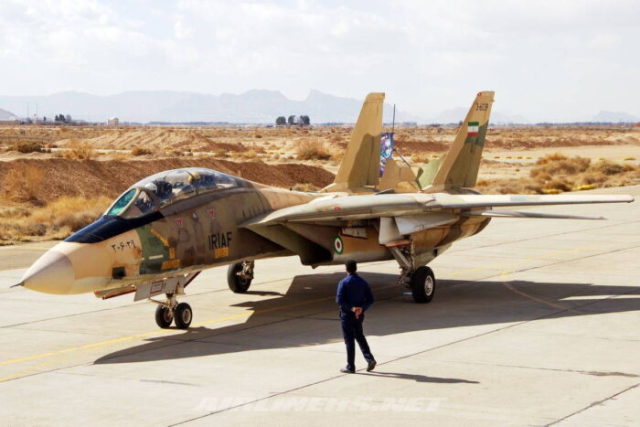
Iranian Air Force F-14 Heavy fighter
The capabilities of the F-14 turned out to be so developed that the export version of the fighter was never officially developed, and the machines sent to Iran, after some light modifications, were produced with American military markings. It had to be erased on the spot by American instructors who flew overseas to train Iranian pilots.
The events after the Islamic Revolution and the subsequent American embargo led to the fact that in the early stages of the Iran-Iraq war, just over a dozen of the 79 delivered Tomkets remained serviceable. The Iranians never received the eightieth fighter and continued to demand compensation or delivery of the aircraft for decades. Since the United States has not yet installed modern AIM-7 and AIM-9 short- and medium-range missiles on its aircraft, the armament of the Iranian Tomkets included only guns and Phoenix missiles with a range of up to 200 km on approach. As reported, "Phoenixes" were often successfully used against Iraqi aircraft at ranges of no more than 19 km.
According to Iranian sources, during the entire eight-year war, the Iranian Air Force lost only three F-14As. They allegedly managed to shoot down 160 Iraqi planes. Thanks to its missile armament, the F-14A could neutralize most Iraqi aircraft at a distance several times greater than the range of their return fire. The Tomkets gained a "deadly" reputation as a highly effective means of air combat and their mere presence was enough to "turn entire Iraqi aviation units away from an attacking mission."
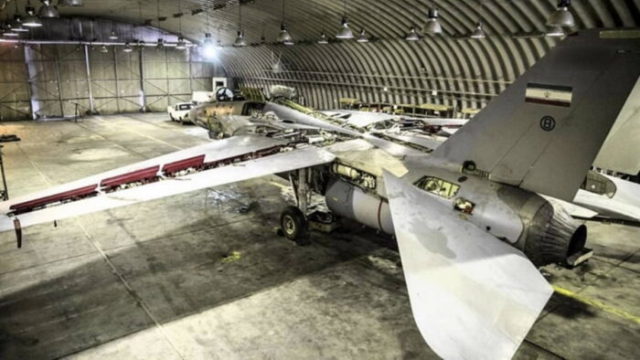
Tomket is in the hangar. The lack of spare parts affected the readiness of the fleet of these aircraft
Meanwhile, Iran's ability to purchase spare parts for the Tomket fleet remained limited. The country was able to deploy production facilities to service the simpler-designed F-5E, and through reverse engineering and the purchase of spare parts on the black market to maintain its "Phantoms" in operational readiness. However, this was not enough for the much more complex F-14 (given that Iran was the only foreign customer of these aircraft).
After the end of the war, a serious shortage of Phoenix missiles further limited the operational availability of Tomkets. Only a small part of the fleet of this model remained in working condition for several decades. At the same time, recently, relying on a number of new technologies, including 3-D printing, Iran has managed to more effectively reconstruct parts for both the F-14 airframe and its missiles. This made it possible to produce a more capable own version of the Phoenix rocket and return to service most of the long-dormant F-14A fleet.
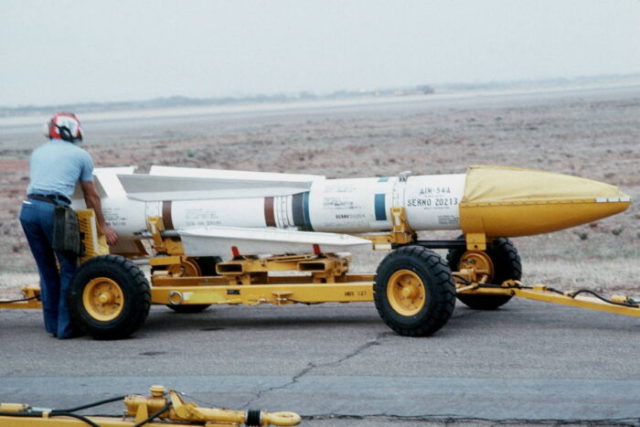
AIM-54 Phoenix air-to-air missile
According to publications, each of the F-14 fighters of the IRI Air Force received more than 250 modifications and updates, including the installation of new radars, displays in the cockpit, electronic warfare kits and other critical avionics. Iran has also made significant efforts to develop a missile capable of replacing the Phoenix. According to some reports, a copy of the AIM-54 and an entire F-14 were sent to the Soviet Union for study in exchange for assistance in developing the necessary missile. The IRI Air Force Command officially announced the start of serial production of a new 450-kilogram missile in 2018.
According to Iranian sources, like the Phoenix, the Fakur-90 missile retained a guidance system capable of providing radar capture of a target regardless of the launch aircraft's own radar. The more efficient fuel composite used in the new ammunition, developed with the assistance of Russia, according to the same sources, provides the Iranian missile with a range of about 300 km, which is slightly less than that of its Russian counterpart R-33.
Iran's Fakur 90 missile
As a result, the "Tomkets" of the IRI Air Force equipped with the Fakur-90 are capable of hitting the enemy at distances four times higher than the main American air-to-air missile AIM-120B (with a range of 50-70 km) and almost twice its more advanced version AIM-120C (with a range of up to 180 km). Since the Fakur-90 has a hypersonic speed of Mach 5, calculations show that in the event of a regional war, Iranian Tomkets, without leaving their own airspace, will be able to hit Saudi and Israeli F-15 armed with AIM-120 relatively safely on approach to the territory of the country.
At the same time, Western experts estimate the capabilities of the Fakur-90 more modestly and believe that the real range of the missile is within 220 km (some sources give 100-150 km). However, even in this case, given the reliance on its own production of APS, the threat posed by the modernized and rapidly growing Iranian fleet of F-14 fighter jets (at least 40 vehicles in operation) remains very significant for the United States and its regional allies.
Since, for well–known reasons, most of the "Tomkets" of the IRI Air Force have served for less than 10 years, and some for less than five, their gliders are, in fact, completely new and have a significant operational resource. According to some estimates, the Iranian F-14A in combination with the new Fakur-90 missile can have a significant impact on the capabilities of the national Air Force to conduct air warfare.
Continuation:
According to the materials of the resource militarywatchmagazine.com
